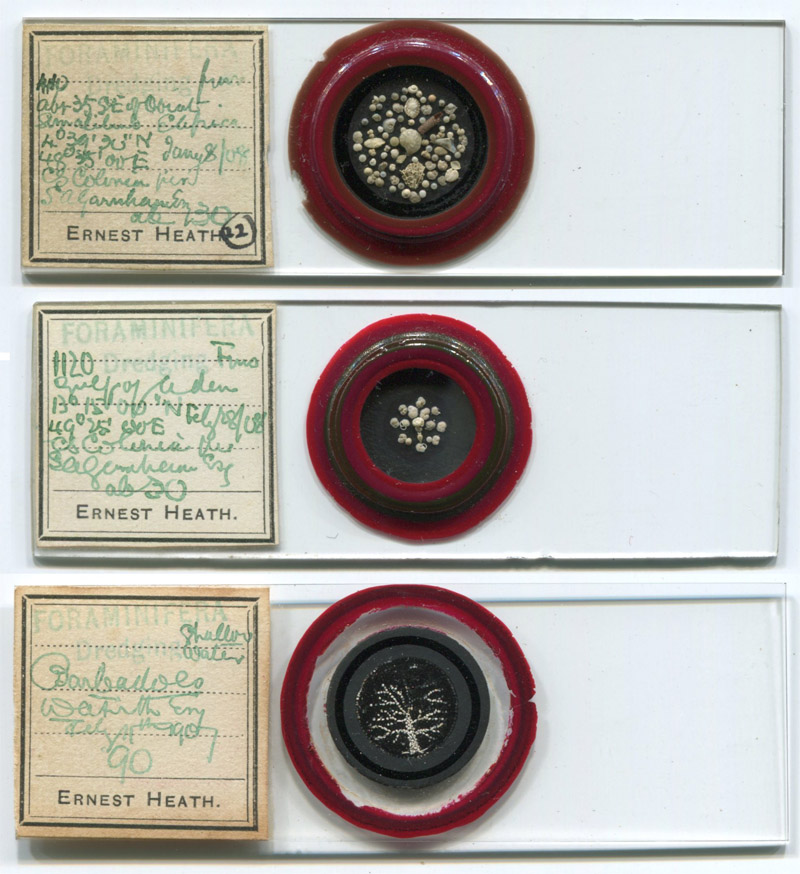
Figure 1. Microscope slides of foraminifera, prepared by Ernest Heath. The top two are dated 1908, and the lower one, from 1907.
Ernest Heath, 1860 - 1942
by Brian Stevenson
last updated December, 2014
Amateur microscope slide maker Ernest Heath specialized in foraminifera, often arranging gatherings into patterns (Figures 1-3, 7). There are no records of Heath having sold any of his preparations, although it is likely that he exchanged slides with colleagues in the societies of which he was a member. Ernest and his two brothers were owners/managers of a “patent fuel” company in Cardiff, Wales, which produced compressed bricks of processed coal. That business evidently afforded Heath with the free time to make his spectacular arrangements. He was also able to travel widely, as evidenced by his description of foraminifera that he collected while swimming at a resort in the Adriatic Sea.
Heath donated an extensive collection of his work to the National Museum of Wales. At the time of this writing (December, 2014), that museum’s web site stated “We don’t know much about him, apart from that he was a fellow of the Royal Microscopical Society, somehow got hold of deep-sea mud from around the world, and must have had a lot of time on his hands!” This should caution people who plan to donate to museums that they should also provide a personal history, lest the donor be forgotten.

Figure 1.
Microscope slides of foraminifera, prepared by Ernest Heath. The top two are dated 1908, and the lower one, from 1907.
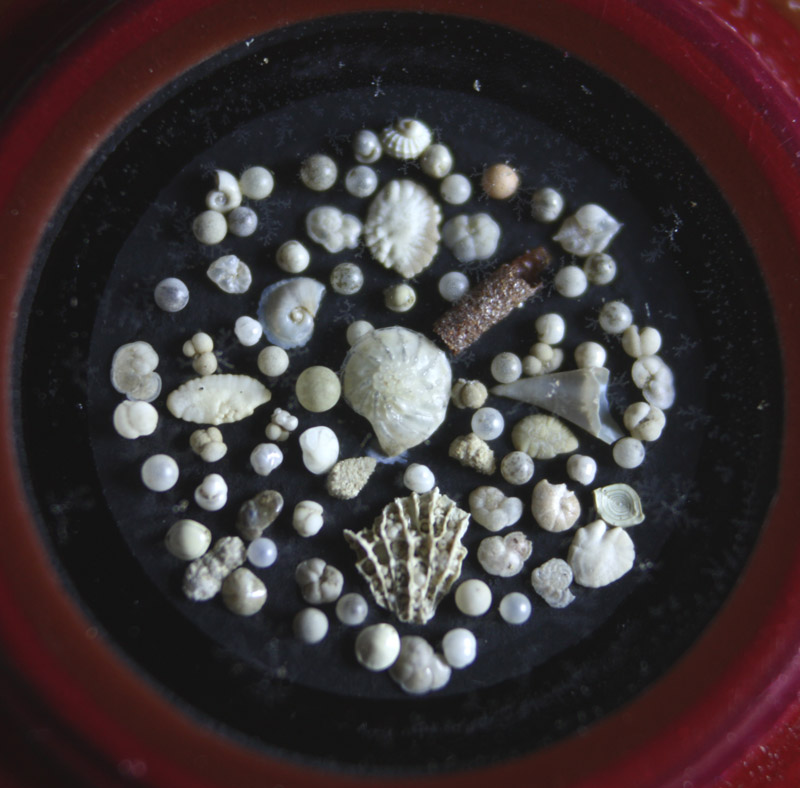
Figure 2.
Detail of a January 8, 1908 slide of material collected off the coast of Somalia, 4o 39’ 30” N, 48o 35’ 00” E.
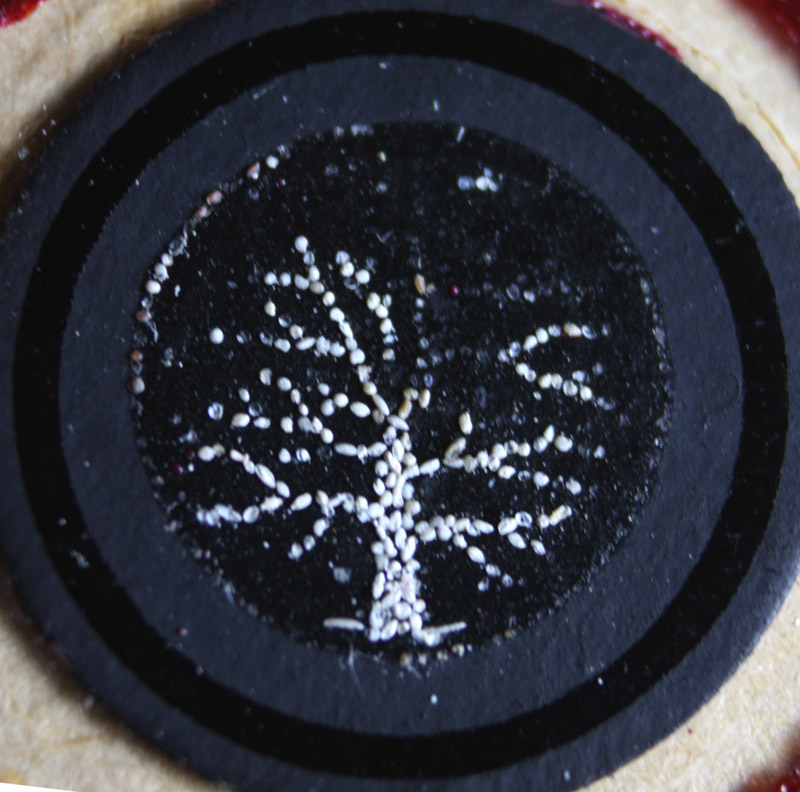
Figure 3.
Foraminifera collected from shallow waters in
Barbados, arranged on July 11, 1907, into the shape of a tree. Unfortunately,
the cell has been lost from this slide, as have many foraminifera, but the artistry
is still striking.
Production of “patent fuel” in Cardiff began in 1846, being produced from small coal fragments that were heated, mixed with powdered pitch, then compressed into blocks. Bricks of patent fuel could be efficiently stacked for use in ships, etc. However, the porous nature of the early bricks absorbed moisture, which limited the length of time which they could be stored. Ernest’s father and eldest brother, Thomas Edward Heath Sr. and Jr., and a colleague, Thomas Evens, developed and patented a "dry heat" method of fuel production, which avoided those problems. In 1874, Heath, Sr. opened the Star Patent Fuel Works in Cardiff. When the father died in 1882, three of his sons, Thomas Jr., Ivor, and Ernest, took over operations of the plant.
Ernest was born during the summer of 1860. Even before his father began his independent business, the Heaths were evidently well-off, with the 1861 census listing the family as having a governess, a nurse, a cook and a general domestic servant.
Ernest married Annie Martha Wilson during the summer of 1887. They appear to have had three daughters, Annie, Lorna and Jocelyn.
It is not clear when Ernest began seriously working with the microscope, but he was evidently an adept mounter by 1893. In that year, he donated to the Welsh National Museum, “a museum microscope with slides of foraminifera collected off the Welsh coasts and mounted by Mr. Ernest Heath…, who intends to add to them from time to time”. In 1907, Ernest joined the Cardiff Naturalists’ Society, and for many years thereafter was a regular exhibiter of foraminifera slides at Society meetings. He was elected Fellow of the Royal Microscopical Society in 1909.
Also in 1907, Ernest made an expansive collection of foraminifera available to the public. The editor of Knowledge wrote, “By the kindness of Mr. Ernest Heath, of Cardiff, I am able to offer for distribution to my readers a considerable quantity of anchor mud and dredger sand from the Adriatic. Mr. Heath says: ‘I made these gatherings myself, and a friend sent me a great many. They extend over a fairly wide area on the eastern coast from Trieste to Spalato. Your readers will, I think, find them very rich in Foraminifera and Mollusca, but the diatoms I expect I have pretty well washed out in getting my own floatings. There is a very wide range of Foraminifera and abundant beautiful specimens of Pencroplis planatus. I have also had some very curious and abnormal specimens of Polymorphina. The Adriatic is one of the richest seas in Foraminifera. I was bathing from the shore on one of the Brioni Islands, and as I walked into the sea the sand rose up and floated around my legs in clouds, just the same as one sees it when washing and floating the gatherings. I should think that 50 or 60 per cent of the sand is composed of the empty shells’. In a further letter, Mr. Heath says: ‘With reference to procuring supplies of dredgings and ocean ooze, one of the best plans I know of is to get in with an officer of one of the cablelaying steamers, which take soundings in great depths. I have so far failed myself to get to know one, but hope some day I may do so. I have had a lot of very excellent material, however, from the steam trawlers that work out from Cardiff. I wrote to a member of one firm asking him if he would kindly allow me to board his trawlers when they arrived in, to scrape the sand from the crevices of the trawls, and he most kindly gave his superintendent instructions that I was to have every facility, so that I collected from the different trawls from pretty nearly all the grounds they visited, including off 'The Smalls'; off 'The Wolf’; the Atlantic, 150 miles west of Lundy; off the Basketts (Cape Clear, S.W. Irish coast); 30 miles S. of Kinsale Head; off Ushant, Finisterre, &c. I also had some very fine material collected by an officer on H.M.S. Euryalus when on the Australian station. These include Broken Bay, Hawkesbury River, N.S.W., 7 fathoms; Largs Bay, S.A., 6 fathoms; Auckland, N.Z., 6 fathoms; Port Lincoln, S.A. (poor), 9 fathoms; Hobson's Bay, Melbourne (very poor), 5 1/8 fathoms; Sydney Harbour, N.S.W. (very rich), 8 1/8 fathoms; off Ceylon, Indian Ocean, 35 fathoms; Colombo Harbour, 7 fathoms; Suez (Egypt), and Port Said, 28 fathoms. He also had some from Aden, but said it putrified and stunk his cabin out so he had to commit it to the deep again. This officer is now in home waters, and has offered very kindly to collect for me more material when the opportunity occurs. The Adriatic anchor mud, &c, with the exception of five, which I got myself, were sent me by an officer in the Austrian Navy, and were taken from a torpedo-boat, on which he was cruising. One of them was actually taken from a discharged and recovered torpedo, which should have had a very good sample as it would lie running along the bottom for some little distance when slowing down. This officer I had interested very much when I was over there last year, showing him with a pocket lens of 20 diameters the lovely little shells. He has also promised to send me more when he has an opportunity’. I wish I could reproduce more of Mr. Heath's very interesting letters, which show how an enthusiastic collector may enlist the help of others for his hobby. Those of my readers who would like some of this sand must send me a stamped addressed envelope, a small tin box, and the coupon to be found in the advertisement columns of this issue. May I add that the number of applicants is generally so great that I cannot pay any attention to applications which do not carry out all of these simple conditions. It would be amusing were I to detail some of my experiences in distributing material of this nature.” Later that year, Knowledge also reported that Heath had made available “a supply of washed foraminiferal shore gatherings from Dog's Bay, Galway, Ireland, consisting almost entirely of minute shells”.
To the best of my knowledge, Heath did not publish details on how he manipulated the foraminifera while making his arrangements. But, in 1908, he wrote an article on a device he invented for sorting forams out of gatherings, and implied that he used a bristle brush for moving the specimens. It is reasonable to assume that he also used this apparatus during slide mounting:
“For some considerable time I have found in using the dissecting microscope, that it is very much easier and simpler to move the material backwards and forwards under the lens, than to move the lens over the material on the swinging arms provided with most dissecting stands. This is more especially so when working by lamplight and with a condenser, as frequently the position of these has also to be readjusted.
About a year or so ago, I constructed a movable stage from wood, actuated in two directions at right angles by screws, but the condition of the atmosphere rendered the screws difficult to work by reason of the wood slides, in which the apparatus moved. I then had some brass castings made, and these were completed some three weeks ago, and the whole thing works admirably.
As will be seen from the photographs, the mechanical stage consists of two slides, similar to the sliderest of a lathe, working at right angles with one another and actuated by screws. The top plate of the upper slide is let into and screwed firmly to the underside of a Barnes Dissecting Stand, made by Messrs. Bausch and Lomb. This works three inches in either direction. On the top of the glass stage I place (for Foraminifera, which is my particular study) a glass tray, made of a double thickness of glass, cemented together, leaving on the bottom side a trough for sweeping the selected forams into. The top plate has on the underside, before being cemented, twelve lines, a quarter of an inch apart, and one inch in length, cut in with a diamond. These form guides to work by when under the lens. This can be seen more distinctly in the second photograph, where it is placed against the stand. I work up one line, then traverse across to the next, and in this way the material to be looked over is thoroughly searched without missing any of the ground. The lens-holder is one of Bausch and Lomb’s T.U.S. holders, which is easily adjustable to almost any height, and focusses easily with a diagonal rack and pinion. With a x-20 lens the field taken is about halfway between the two lines, whilst a x-10 takes in very comfortably the space between the two lines.
The Foraminifera, which are collected in the little trough of the tray, are then brushed into one of the watch glasses, shown in the little box holding four glasses, and are put on one side till the mounting time comes round, which is generally when about sixty glasses have been used.
Of course, it is very necessary that the slides should be accurately planed, scraped, and fitted together, so as to ensure their working quite smoothly. The bottom screw should be of a good deal coarser pitch than the top one, as this is required to work quicker, not being used under the lens.
The little tray for picking out Foraminifera, already alluded to, I made some two or three years ago and have worked with it ever since. Of course, it is used over a dark-ground plate, and I think I may safely say that the use of it increased the speed in picking out Foraminifera from my gathering fully 100 per cent. As can be seen from the second photograph, it consists of five pieces of glass cemented together, the base piece being 3 1/2 by 2 1/2 inches; the upper top-piece, on which the guide-lines are cut with a diamond, being about 3 1/2 by 1 3/4 inches, with the lower edge bevelled. The lower piece is 3 by 1/4 inches, with the top edge bevelled, and two small pieces about 3/4 by 1/4 inch form the two ends to the trough, which is about 3 by 1/2 inches. These two sides have not bevelled edges, as it is sometimes convenient when the Foraminifera are reluctant to leave the bristle, to have the square edge to scrape them off with. In working the larger grades they are pulled off the tray with a fine wire, bent to a half-hook, and mounted on a needle-holder. With a good gathering I have often got over 1,000 forms in about an hour.
The little cases to hold the watch-glasses are very convenient, as one can store away any number of these with picked material without dust getting in, as they are all fitted with glass covers with ground edges."
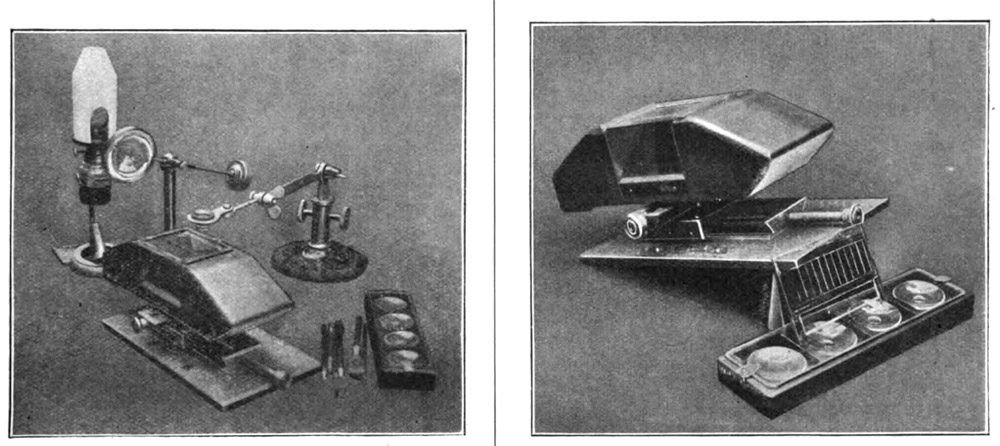
Figure 4.
Illustrations that accompanied Ernest Heath’s 1908
paper on his inventions for sorting foraminifera.
By 1922, Ernest had retired from business, and relocated to Sennen, Cornwall. He remained a corresponding member of the Cardiff Naturalists' Society through the late 1930s, possibly until the end of his life. He died in Sennen of August 13, 1942.
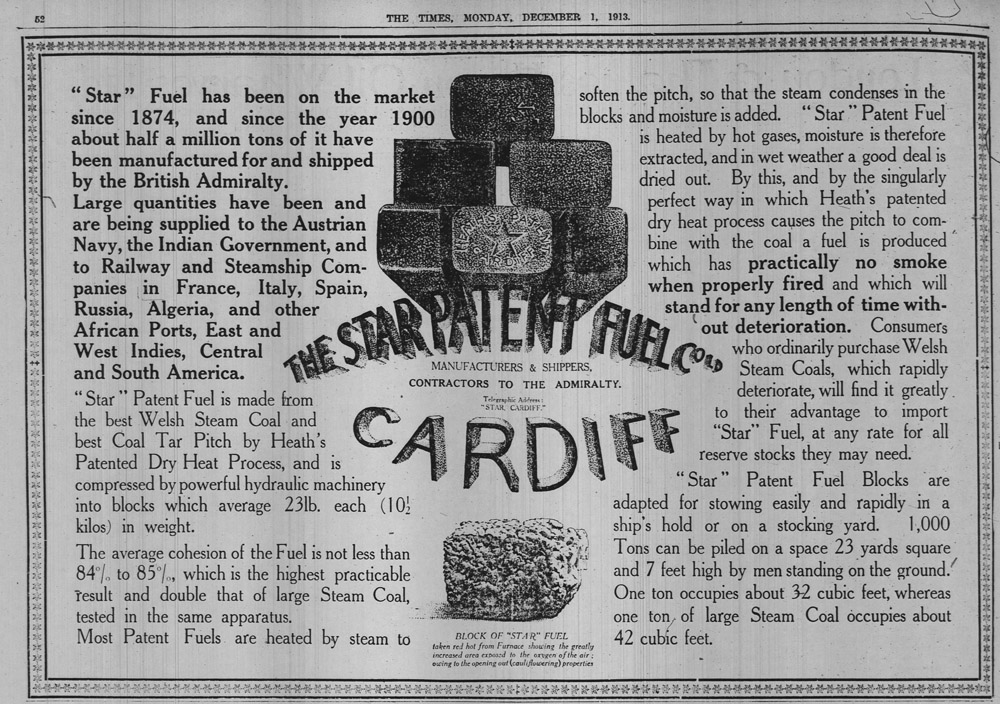
Figure 5.
Advertisement by Heath’s Star Patent Fuel Company,
from ‘The Times’ (London), December 1, 1913.

Figure 6.
Advertisement from the 1907 ‘South Wales Coal Annual’.
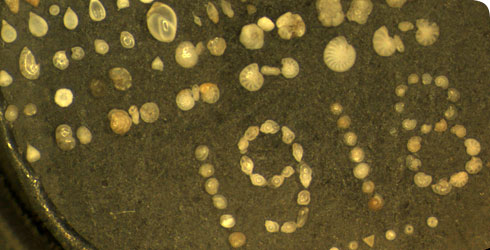
Figure 7.
Detail of an Ernest Heath microscope slide held in
the National Museum of Wales. Reproduced for nonprofit, educational purposes
from http://www.nhm.ac.uk/research-curation/collections/our-collections/invertebrate-collections/historical-marine-collections/other-institutions/national-museum-wales/geology-palaeontology-collections.
Resources
Annual Report of the Cardiff Welsh Museum of Natural History (1893) “Two important gifts, promised for the Welsh National Museum when the question of the allocation was under consideration by the Treasury, have been received. The one is the large stereoscope and a set of stereograms of the sun and stars, the distances of which have been measured in space of three dimensions, which the inventor and donor, Mr. Thomas E. Heath, F.R.A.S., recently exhibited at the Royal Society. The other is a museum microscope with slides of foraminifera collected off the Welsh coasts and mounted by Mr. Ernest Heath (brother of the above), who intends to add to them from time to time”, page 8
Cardiff Naturalists Society Reports and Transactions (1907) Vol. 40, page 48
Cardiff Naturalists Society Reports and Transactions (1922) List of members: “Heath, Ernest, ‘Clidga’, Sennen, Cornwall”, Vol. 52, page 75
Cardiff Naturalists Society Reports and Transactions (1937) List of members: “Heath, Ernest, FRMS, ‘Clidga’, Sennen, Cornwall”
Heath, Ernest (1908) Mechanical stage for dissecting microscope, Vol. 31, page 173
Heath, L.I. and F.A. Jenkins (1969, accessed on-line December, 2014) Star Patent Fuel Works, http://www.irsociety.co.uk/Archives/24/Star_Patent.htm
Heath, Thomas Edward (1906) Tales in Prose and Verse, and Dramas, King, Sell and Olding, London
The Institution of Mechanical Engineers Proceedings (1906) Star Patent Fuel Co., Cardiff, page 622
Journal of the Royal Microscopical Society (1923) List of Members: 1909, Heath, Ernest. Clidga, Sennen, Cornwall.
Knowledge (1907) Microscope material, Vol. 30, pages 22-23
Monthly Notices of the Royal Astronomical Society (1919) Obituary of Thomas Edward Heath (Jr.), Vol. 79, page 229
National History Museum Geology and Palaeontology Collections (accessed December 2014) http://www.nhm.ac.uk/research-curation/collections/our-collections/invertebrate-collections/historical-marine-collections/other-institutions/national-museum-wales/geology-palaeontology-collections
National Museum of Wales, Microscopic designs: Ernest Heath's collection of Foraminifera (accessed December, 2014) http://www.museumwales.ac.uk/rhagor/galleries/foraminifera/
Probate of Ernest Heath (1942) “Heath Ernest of Clidga Sennen Cornwall died 13 August 1942 Probate (limited) Bodmin 15 April to Annie Martha Heath widow. Effects £8547 6s 9d”
South Wales Coal Annual (1907) Advertisement from Star Patent Fuel, J. Davies, Cardiff, page xl
The Times (London) (1913) Advertisement from Star Patent Fuel Co., December 1, 1913, page 52
Wales and England census, birth, marriage and death records, accessed through ancestry.co.uk